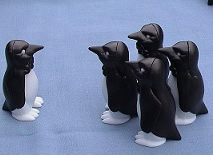Week Twelve Formative Evaluation (small group)
Moving from 1-1 Evaluation to Small Group Evaluation
Now that you have completed the one-to-one phase of formative evaluation, it's time to turn your attention to phase two: small-group formative evaluation.
The main difference between one-to-one and small group evaluation (apart from the obvious difference in the number of learners) is the level of involvement of the instructor/designer. In one-to-ones, you should have been very involved in discussing, observing, and recording individual learner interaction to your materials. In small-group evaluation, you are essentially conducting a pilot test under 'laboratory' condition.
Typically, the small group evaluation begins with a pretest (if that's part of your instructional strategy), then the instruction is presented, followed by a posttest (as appropriate). The 'laboratory' conditions include your observations, an attitude questionnaire, and follow-up debriefing or discussion between you and the learners after the instruction has concluded.
Start by reading Ch. 10, p. 266-268. Then, reread p. 279-280 for the specific steps. Create a plan for conducting your small-group evaluation.
Here are the items you should consider in your plan.
- Who are the sample learners? You should choose a minimum of eight (if possible), according to the guidelines in Dick and Carey on p. 292.
- Where will I conduct the evaluation?
- What procedures will I use?
- What kind of data do I want to collect? See Table 10.5 on p. 320 for a sample attitude questionnaire.
- How do I analyze the data? See the tables and figures in Ch. 11 for possibilities.
- How will I report the results?
- in section 4.2, describe how you selected the learners and the tools, methods and procedures (including setting) for the evaluation
- summarize data on pre- and/or posttests, as well as attitude survey
- summarize debriefings/discussions with learners after instruction/assessment activities are completed
The results of your small group formative evaluation efforts constitute section 4.2 of Assignment Four.
Then What?
In some cases, it will be easy to modify the instruction to correct the problems identified during the evaluation process. Other problems may require significant revisions. Use Table 11.6 on page 313 to summarize the proposed revisions to your instruction. No actual revisions to your draft are required for grading purposes.
Required Reading
- Chapter 10-11 (skimming)
Assignment
- Develop a rough draft of your instructional materials and try to complete either a one-to-one or small group evaluation, summarizing the results in assignment 4.2. Prepare to discuss on Monday night.
Online Class Discussion
Monday night, 8-9:30 p.m., Eastern time via Webex.
- 8:00-8:10 Introductory discussion
- 8:10-8:45 Discussion of small-group formative evaluation techniques. Discuss logistical issues.
- 8:45-:920 Discussion of your plans for formative evaluation.
- 9:20-9:30 Preview of next week
Please email me with any questions.
Contact Me
codone_s@mercer.edu
Office: 478-301-4185

Small group evaluation...